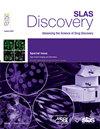Identification of novel inflammasome inhibitors via cellular NLRP3 target engagement assays
IF 2.7
4区 生物学
Q2 BIOCHEMICAL RESEARCH METHODS
引用次数: 0
Abstract
The NLRP3 (NOD-like receptor family, pyrin domain-containing protein 3) inflammasome, a multiprotein complex, plays a crucial role in triggering the release of pro-inflammatory cytokines like interleukin-1 beta. Abnormal activation of NLRP3 can mediate an aberrant immune response to viral infections and is associated with inflammatory diseases. In this study, the goal was to identify bioactive, potent, and specific inhibitors of NLRP3 that could modulate the inflammasome pathway and assess their potential therapeutic relevance. An innovative workflow was assembled by setting up a robust cellular-based high throughput screening (HTS) target engagement (TE) tool to identify potent NLRP3 inhibitors and validate their functional effect on the inflammasome downstream signaling cascade. A subset of 2,500 compounds from the European Chemical Biology Library (ECBL) was screened and validated inhibitors were subjected to a similarity study by state-of-the-art computational tools to comprehend their specific impact on inflammasomal signaling nodes upstream of NLRP3 and to propose feasible anti-inflammatory drugs. Ultimately, ten compounds were selected and validated in functional checkpoints of the NLRP3 inflammasome pathway, such as caspase-1 activity and IL-1β release, proving the validity of this HTS TE method for identifying NLRP3 inhibitors. Subsequent similarity-based clustering suggested the organization of the active compounds into three primary groups, linked to NF-κB signaling, ROS-induced NLRP3 activation, and NLRP3 induction pathway in response to microbial and related insults. Overall, these findings demonstrate the robustness and efficiency of the target-engagement methodology to capture bioactive inflammasome inhibitors with diverse mechanisms of action. Seven of the identified NLRP3 inhibitors were characterized as novel inflammasome inhibitors with therapeutic potential.

通过细胞NLRP3靶结合试验鉴定新型炎性体抑制剂。
NLRP3 (nod样受体家族,pyrin结构域蛋白3)炎性小体是一种多蛋白复合物,在触发白细胞介素-1 β等促炎细胞因子的释放中起着至关重要的作用。NLRP3的异常激活可以介导对病毒感染的异常免疫反应,并与炎症性疾病有关。在这项研究中,目的是鉴定可以调节炎性体途径的NLRP3的生物活性、强效和特异性抑制剂,并评估其潜在的治疗相关性。通过建立一个强大的基于细胞的高通量筛选(HTS)靶标结合(TE)工具,建立了一个创新的工作流程,以识别有效的NLRP3抑制剂,并验证它们对炎性小体下游信号级联的功能影响。从欧洲化学生物学文库(ECBL)中筛选2500个化合物,并通过最先进的计算工具对抑制剂进行相似性研究,以了解它们对NLRP3上游炎症小体信号节点的具体影响,并提出可行的抗炎药物。最终,我们选择了10个化合物,并在NLRP3炎症小体通路的功能检查点(如caspase-1活性和IL-1β释放)中进行了验证,证明了这种HTS - TE方法识别NLRP3抑制剂的有效性。随后基于相似性的聚类表明,活性化合物可分为三大类,分别与NF-κB信号传导、ros诱导的NLRP3激活和NLRP3诱导途径有关,以应对微生物和相关的损害。总的来说,这些发现证明了靶向参与方法在捕获具有不同作用机制的生物活性炎性体抑制剂方面的稳健性和有效性。鉴定出的7种NLRP3抑制剂被定性为具有治疗潜力的新型炎性体抑制剂。
本文章由计算机程序翻译,如有差异,请以英文原文为准。
求助全文
约1分钟内获得全文
求助全文
来源期刊

SLAS Discovery
Chemistry-Analytical Chemistry
CiteScore
7.00
自引率
3.20%
发文量
58
审稿时长
39 days
期刊介绍:
Advancing Life Sciences R&D: SLAS Discovery reports how scientists develop and utilize novel technologies and/or approaches to provide and characterize chemical and biological tools to understand and treat human disease.
SLAS Discovery is a peer-reviewed journal that publishes scientific reports that enable and improve target validation, evaluate current drug discovery technologies, provide novel research tools, and incorporate research approaches that enhance depth of knowledge and drug discovery success.
SLAS Discovery emphasizes scientific and technical advances in target identification/validation (including chemical probes, RNA silencing, gene editing technologies); biomarker discovery; assay development; virtual, medium- or high-throughput screening (biochemical and biological, biophysical, phenotypic, toxicological, ADME); lead generation/optimization; chemical biology; and informatics (data analysis, image analysis, statistics, bio- and chemo-informatics). Review articles on target biology, new paradigms in drug discovery and advances in drug discovery technologies.
SLAS Discovery is of particular interest to those involved in analytical chemistry, applied microbiology, automation, biochemistry, bioengineering, biomedical optics, biotechnology, bioinformatics, cell biology, DNA science and technology, genetics, information technology, medicinal chemistry, molecular biology, natural products chemistry, organic chemistry, pharmacology, spectroscopy, and toxicology.
SLAS Discovery is a member of the Committee on Publication Ethics (COPE) and was published previously (1996-2016) as the Journal of Biomolecular Screening (JBS).
 求助内容:
求助内容: 应助结果提醒方式:
应助结果提醒方式:


